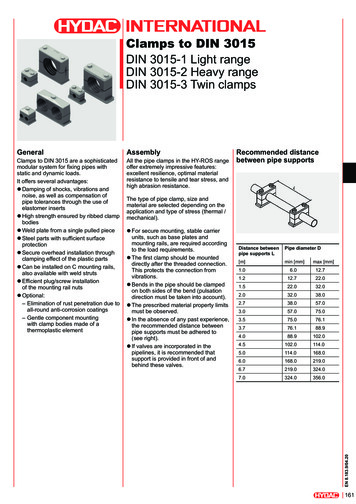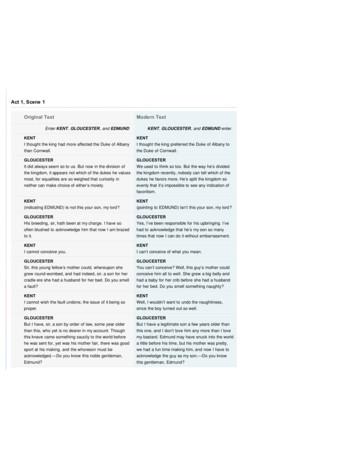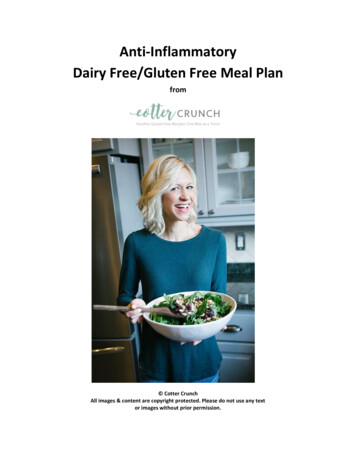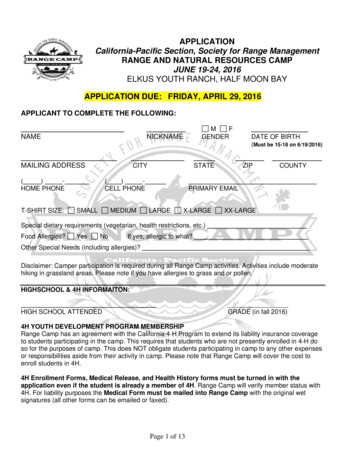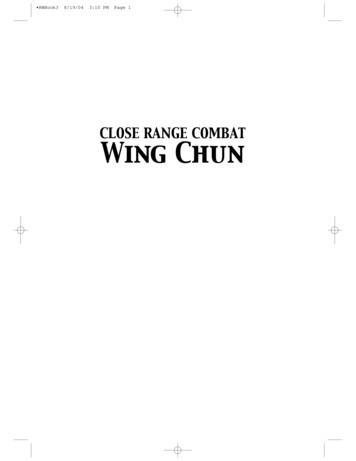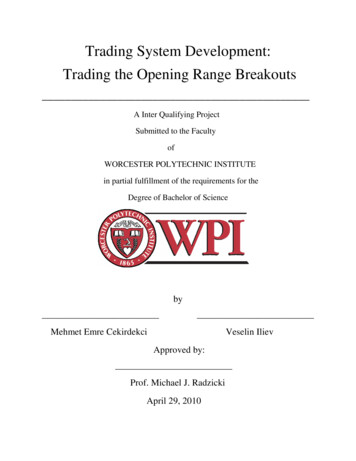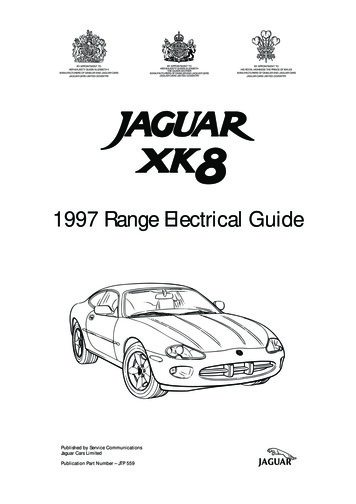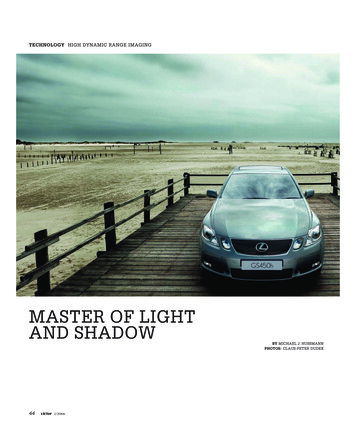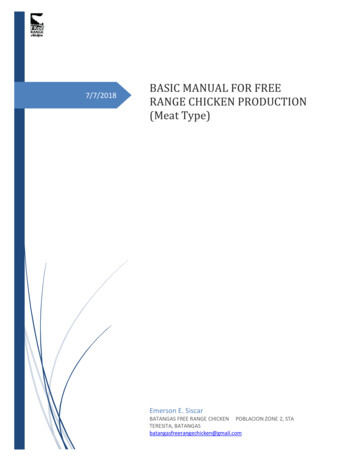
Transcription
7/7/2018BASIC MANUAL FOR FREERANGE CHICKEN PRODUCTION(Meat Type)Emerson E. SiscarBATANGAS FREE RANGE CHICKEN POBLACION ZONE 2, STATERESITA, BATANGASbatangasfreerangechicken@gmail.com
IntroductionThe evolution of Free-range poultry system in the Philippines has gone thru a lot of challenges since itstarted in 1997. From a level of a novelty or hobby chicken, to a small scale backyard level, this haseventually progressed into a level of semi-commercial to a formal commercial production. The loyalclients of the free-range poultry meat have been growing thru the years because of the more natural,delicious taste and health benefits from the meat if chicken are raised in an antibiotic free system.At present, the advocacy in promoting free-range chicken farming both for meat and eggs has beenchallenged by over commercialism of opportunistic and predator traders. Some traders promote freerange chicken and eggs even without knowledge of the system and what exactly is the essence of goinginto free range chicken farming. One must know the farmer and the source most importantly. Same istrue in getting quality chicks. There are also vendors that exploit the innocence of farmers by misleadingthem and giving substandard products from sources that offer very minimal technical guidance. It is ofprime importance that the farmer must have genuine high quality day old chicks to attain goodproduction results. When you use the right tools and correct skills you will eventually produce the rightproduct!FREE-RANGE CHICKEN FARMING, FOR SMALL FARMERS, IS ABOUT QUALITY PRODUCTION, NOTQUANTITY.A substantial income can be generated if properly done in small volume while you will be enjoying handson farming without the stress and pitfalls of over commercialization.The proper farming skills that are needed to produce a high quality free-range chicken meat and qualityeggs is the second most important foundation. Farmers must educate themselves.We recommend, that if you are a starting farmer, one may practice on small volume to overcome thelearning curve with minimal waste of time and other resources. Personally, I say this also depends onyour risk appetite. If you have acquired the proper knowledge or a legitimate veterinarian / technicianguided you correctly, then you can venture to a much bigger volume of produce.Know your market well. We encourage farmer to determine target market in Free-range chickenmarketing since this is still a niche market. Always be prudent with the volume that you produceagainst the actual volume of chicken that the market in your area can really absorb. A gradualintroduction of your produce to the market can give you surprising results due to the very good tasteand health benefits of the free-range chicken meat.Lastly, always consult a veterinarian or technician that is well versed with free-range chicken productionsystem. Always remember that success in livestock production is also dependent on the proper guidanceof experienced farmer or individual.1 P a ge
Terms of Reference:1. Batangas Free Range Chicken - Free range day-old-chick distributor2. Free range Day-Old-Chick. High quality day-old chicks produced out of GRIMAUD FRÈRES Parentstocks imported from Roussay, France.3. Farmer. Refers to interested individual who will raise / manage free-range chicken grow-outoperations. These farmers can raise from 50 heads to 5,000 heads depending on the skill level andexperience of the farmer.4. Technicians. These are the skilled personnel, properly taught by the Free-range chicken specialist,who assist and teach farmers in operating the free-range chicken farm5. Veterinary specialists. Veterinarian that has extensive experience in free-range chicken breeding,hatchery, and meat grow-out production.6. Brooding. The stage of growing the chicks from day old to 21 days. This is the time when you provideartificial heat to the chicks. This is like the nursery stage.7. Ranging stage. Refers to the time of 21 days up to harvest time when the birds are allowed to grazein the ranging area.8. Growing stage. The specific stage of 22 days up to 40 days where the increase in growth rate is high.9. Finishing or Harvest stage. The specific stage of 41 to 55 days (harvest time) or 81 days for slow growsystem.Importance of Parent stocks to sustain a steady supply of good quality day old chicks We need a set of chicken that are of nearest possible UNIFORM PURE LINE of traits.PARENT STOCK BREEDERS (P.S.) are not related. This prevents abnormalities in theF1 producedP.S. are of the same age and built quality.P.S. are coming from Grand Parent Stock Breeders that were managed properly andwith complete vaccination.P.S. consume almost the same amount of feeds and are managed uniformly.P.S. Females produce a high number of high quality hatching eggs (60 gram eggs), high qualitychicks (40-45 gram chicks), provided that they are managed properly and within standards.The offspring (F1) are efficient in feed consumption (good converters of feeds to meat).Why we cannot use F1 as breeders? Technically, they are “brothers and sisters” extreme inbreeding abnormalities, highmortalities, irregular and small sizes poor quality chicks producedPoor sanitation, incomplete vaccination and medication program source of contaminationsand diseases bad quality2 P a ge
F1 will produce approximately 90 eggs which will hatch approximately 50 chicks vs. Certified P.S.which will produce approximately 160 eggs and hatch approximately 140 chicks.F1 will consume 75 kilos of feeds compared to 42 kilos by the certified P.S.Will result to high percentage of mortality, losses, failure.Why do we need certified F1 in producing good quality free range chicken meat? A meat-type producer capable of an average of 1.6 kilos live weight at 56 days. If raised on a fastgrow system.Ideal harvest age is 56-60 days.Feed conversion ration FCR 1.90Estimated feed consumption per head up to 56 days is 2.8 kilos.Can be used also as a backyard-type free-range chicken and can subsist in the range and withlesser amount of feeds. This is personal consumption only and not for commercial productiondue to lower meat qualityStandard liveability up to 56 days is 97%.Important keys to a successful free-range chicken farming Get Certified F1 free-range day-old chicks of true high quality.Start by: learning to farm with initially a small volume of chicks.Acquire knowledge from and consult with your chick supplier and experienced and practicingtechnicians/veterinarians specializing in free-range production.Prepare a good but simple housing and invest on equipment.Be prepared to receive the chicks.Use only quality feeds, price consideration must be secondary2 CATEGORIES OF FREE-RANGE FARMING1. BACKYARD TYPE FREE-RANGE FARMINGThe main objective of backyard type free-range chicken farming is raise quality poultry produceusing available backyard space while utilizing also available materials for the chicken house. Abackyard production may range anything below 5000 heads. A small production of 1-100 headswith the objective of producing meat for personal or family consumption is a decent start upwhile studying the system. This is usually limited to an area of the household backyard. Cost toproduce is variable depending on available feed materials such as surplus cereals, vegetable andfruits (otherwise ALTERNATIVE SUPPLEMENTAL FEEDS). The source of manpower is acquiredfrom available family members.The quality of meat will always vary on the management and farming principles:a) The irregular feeding program and the variety of feeds (alternative supplemental feeds fromthe household) given to the birds will result to low meat recovery.b) The absence of a regular cycle of loading of chicks and harvesting at a specific time areneeded to maintain a regular supply to stimulate the demand3 P a ge
c) Investments in housing, feeds and equipment are also very important points to consider toproduce uniform production of meat in terms of volume and quality.d) Lack of skilled technical veterinarian for free-range production2. COMMERCIAL TYPE OF FREE-RANGE FARMINGThe main objective of the commercial type of free-range farming is to supply the presentconsumer market in the urban areas with a consistent high quality free-range chicken meat thatis free from antibiotics, synthetic growth hormones, animal protein, pesticides, fertilizers andother chemicals. Also it is very important to note that the free-range chicken meat is thepreferred meat source of children with autism, the elderly, persons inflicted with cancer, andother diseases that are diet sensitive. This type of farming is based on a planned and carefullyorganized investment free-range farming system. The volume of production can be from 5000heads and up per month output on a continuous regular cycle of production whole year round.a) Capitalization and Planning are important foundations for a successful commercial free-rangefarming.b) A marketing system for institutional buyers is also a very important foundation.c) A complete set of farming area inclusive of a large ranging area, standard building, standardequipment with professional manpower are included.d) Skilled Technical Veterinarians or Animal Husbandry professionals are regularly retainedspecialists that assure all the production standards are properly met.e) Strict Bio-security measures must be implemented.f) Standard brooding and grow-out management must always be implemented.g) Investment on good quality feeds, proper feeding programs and health supplementationprocedures must be strictly followed.h) Proper slaughtering and processing of meat to assure hygiene and sanitation.i) Proper packaging and standard sanitary practices are being utilized to assure the safety ofthe consumers of the product.j) A certified source of day-old chicks, feeds and other inputs are utilized to assure theconsumers of High quality Free-range chicken meat. Meat quality is consistently very good.k) Birds are grown on a standard level minimum of 60 days up to 120 days depending on thepreference of the consumersl) Finally, the quality level of the produce conforms to the standards of The Philippineassociation of Free-range poultry advocates.4 P a ge
Standard equipment for 100 Free range Day-Old-Chick under Philippine condition1. Feeding equipment:For Brooding Stage (day-old to 21 days)a. Chick Feeder troughs (1 meter length) 3 piecesb. Bilao (36 inches diameter) 3 piecesFor Growing Stage (22 days old up to harvest, minimum 60 days)a. Tube feeders ( 5 kilos capacity ) 8 pieces2. Watering equipment:For Brooding Stage (day-old 21 days)a. Water Galloners medium 3 piecesFor Growing Stage (22 days old up to harvest, minimum 60 days)a. Water basins with basin guards (1 pair) 8 pairs3. Heating / brooding equipment for brooding stage:Incandescent bulbs 50 watts 2 setsorFor areas without electricity:Used 3 kilo capacity powdered milk can 1 pieceCharcoal ½ sack4. Other standard equipment:a. Light source: 2 x 18 watts CFL lighting or Petromax (for areas with electricity)b. Emergency light sourcec. 1 x 50 gallon Drum as water reservoird. 1 x 5 gallon plastic paile. 1 water dipperf. 1 weighing scale 10 kilo capacityg. Fishnet for perimeter ranging area 100 metersh. Herbal gardenHousing dimension and living space requirement for 100 heads high quality free-rangecolored chicks under Philippine condition1. BROODING AREA (DAY OLD TO 21 DAYS) 8 Square meters per 100 heads A double deckercage of 2 X 1 X 0.5 meters can hold 50 heads per cage.2. MOBILE RANGING HOUSE (22 DAYS UP TO 80 DAYS) 7 x 2 x 2 meters or 14 meters per 100birds. The ranging house can be transferable to another ranging location.5 P a ge
3. RANGING AREA space requirement up to harvest age of 80 days 1 square meter of rangingarea per bird exclusive of the Mobile ranging house. The ranging area is enclosed with fishnet 5feet in height.Possible Brooder housing designs for backyard growerOutdoor brooding house double deck design good for A single elevated brooding pen for 50 heads 1 X 2 Meters 100 heads at 50 heads per deck.A triple deck design of a 2 X 1 X 0.5 meters by 3 levels with side Mobile Ranging houses using pvc pipes, laminated sacks and extensions for heaters. Capacity 150heads G.I. pipes as footing and frame support. 3 X 2 X 1meters6 P a ge
A farmer’s simple design of Mobile Ranging house for 100 heads FENCING MATERIALS FOR THE RANGING AREA 7 X 2 X 1 meters materials based on Bamboo andlaminated sacks Fishnets as fencing for the ranging area. Minimum height is 5 feet. The fishnets are movable for transferring the birds to a greener ranging area.Typical brooding of day old chicks with charcoal heaters An improved system of brooding that utilizes a Brooding cage in a Brooding Center7 P a ge
50 Lively chicks with an incandescent 50 watts heater light bulb.Using Beddings of cut grasses. Take note of the uniform size and quality.Complete feeders and waterers are important, to get excellent resultsShaded areas for ranging improves weight gain by 10-15%8 P a ge
ESTIMATED COSTS AND CONSERVATIVE SPECIFICATIONS1. Day old chick (DOC). Refers to the hatched certified F1 chicks that were hatched with-in the last 24hours.2. Price of day-old chicks. This is dependent on the following:a. Volume of DOC orderedb. The place of delivery (proximity) ,additional air-freight or travel costsc. The regularity of placement of orders or Pre-bookingsd. The type of operation you are doing e.g. dealer, poultry store, institutions(restaurants, hotels), regular grower or first timer (newbie).3. Pricing reference standard of 40 pesos per chick as a parameter4. Feed prices are also dependent on the area of the farm, the volume of feeds you willpurchase and the type of operation you will perform.5. Pricing reference standard for feeds are the following:a.b.c.d.Chick booster: P28 / kiloChick starter: P27 / kiloChick grower / Finisher: P27
who assist and teach farmers in operating the free-range chicken farm 5. Veterinary specialists. Veterinarian that has extensive experience in free-range chicken breeding, hatchery, and meat grow-out production. 6. Brooding. The stage of growing the chicks from day old to 21 days. This is the time when you provide artificial heat to the chicks. This is like the nursery stage. 7. Ranging stage .
